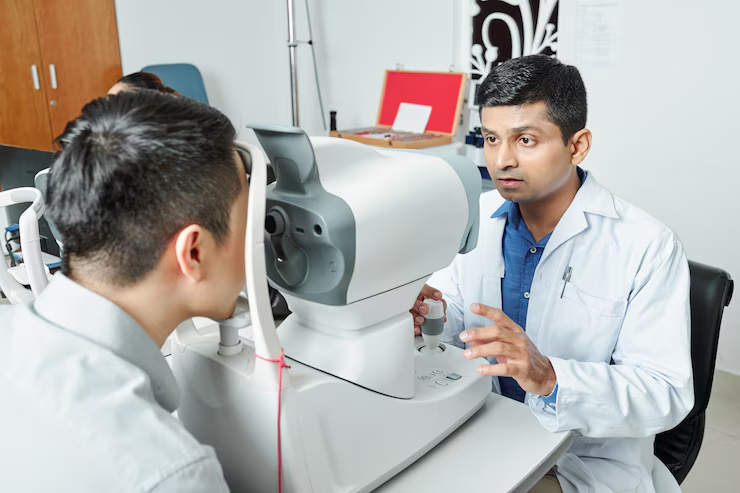Case Study > Improving Diabetic Retinopathy Detection with Deep Learning for a Healthcare Provider
Healthcare
Improving Diabetic Retinopathy Detection with Deep Learning for a Healthcare Provider

Focus Areas
Deep Learning & AI
Computer Vision in Healthcare
Preventive Screening Detection

Business Problem
A leading healthcare provider with a large diabetic patient population struggled with timely screening for diabetic retinopathy (DR), a leading cause of blindness. Manual analysis of retinal images by ophthalmologists was time-consuming, costly, and unable to scale with growing screening demands. As a result, many patients received delayed diagnoses, impacting outcomes and increasing long-term treatment costs. The provider sought an AI-powered solution to improve diagnostic speed, accuracy, and access to early detection.
Key challenges:
Limited Specialist Availability: Ophthalmologists were overwhelmed with screening workloads, resulting in long backlogs.
Subjective Diagnosis Variability: Human interpretations of retinal images varied, reducing diagnostic consistency.
Scalability Limitations: The manual screening process could not keep pace with the increasing number of diabetic patients.
Delayed Interventions: Patients often received diagnoses only after DR had progressed to advanced stages.
The Approach
Curate developed and deployed a deep learning-based diagnostic model that automated the detection of diabetic retinopathy from retinal fundus images. By integrating this system into the provider’s clinical workflow, screenings became faster, more consistent, and accessible at the point of care, improving early detection rates and patient outcomes.
Key components of the solution:
Discovery and Requirements Gathering: Collaboration with stakeholders from ophthalmology, radiology, and IT identified key priorities:
Integrate seamlessly with existing imaging systems (PACS, EMR)
Deliver high diagnostic accuracy and explainable AI outputs
Enable real-time results at the point of care
Meet regulatory and clinical validation requirements
Model Development and Deployment:
Data Collection & Labeling: Curate assembled a diverse dataset of over 100,000 anonymized retinal images labeled by certified ophthalmologists, representing various DR stages.
Model Architecture: A custom convolutional neural network (CNN) was built using TensorFlow and trained to classify DR severity (None, Mild, Moderate, Severe, Proliferative).
Performance Optimization: The model was optimized using data augmentation, dropout layers, and ensemble learning to enhance generalizability and reduce bias.
Interpretability: Grad-CAM visualizations were implemented to highlight image areas influencing predictions, enhancing clinician trust in AI results.
Clinical Integration: Deployed the model via a secure cloud-based API integrated with PACS and EMR systems, delivering results within seconds post-scan.
Process Optimization and Workflow Integration:
Real-Time Screening: Retinal images captured during routine exams were instantly analyzed, with results returned to clinicians before patient discharge.
Flagging High-Risk Cases: Automated alerts notified specialists of severe cases requiring urgent follow-up.
Telehealth Enablement: Enabled remote screening for clinics without on-site ophthalmologists, improving care access in rural areas.
Continuous Learning Loop: The model was retrained quarterly with new data to adapt to imaging device variations and improve accuracy.
Stakeholder Engagement & Change Management:
Clinical Validation: A/B studies were conducted with ophthalmologists comparing AI-assisted vs. traditional diagnoses.
Training & Acceptance: Workshops were held to train clinicians on interpreting AI results and integrating them into decision-making.
Regulatory Alignment: Ensured solution alignment with FDA and HIPAA standards, and documented performance for audit-readiness.
Scalable Deployment: Initial rollout in 5 clinics expanded to 40+ locations within 6 months.
Business Outcomes
Faster and More Accurate Diagnoses
Real-time AI analysis reduced screening time from days to minutes while maintaining ophthalmologist-level accuracy.
Improved Early Detection and Treatment
Increased identification of early-stage DR cases allowed for proactive care, reducing vision loss risk across the diabetic population.
Operational Efficiency
Reduced specialist workload and screening costs enabled clinicians to focus on complex cases and personalized treatment.
Customer Value
Timely Care Access:
Patients received screening results on the same day, expediting referrals and treatment.
Clinical Confidence
Explainable AI helped build trust and fostered collaborative decision-making.
Sample Skills of Resources
Data Scientists: Developed CNN models and trained diagnostic classifiers.
Machine Learning Engineers: Built deployment-ready pipelines and APIs.
Clinical Informatics Specialists: Validated model relevance to real-world ophthalmology practices.
DevOps Engineers: Deployed secure, HIPAA-compliant infrastructure in the cloud.
UX Designers: Designed clinician-friendly AI result dashboards.
Tools & Technologies
Machine Learning & Frameworks: TensorFlow, Keras, PyTorch
Image Processing & Annotation: OpenCV, Labelbox, CVAT
Cloud Platforms: AWS SageMaker, GCP AI Platform
Clinical Integration: HL7/FHIR APIs, DICOM, PACS
Monitoring & Compliance: Prometheus, HIPAA-verified audit logs, SOC 2 certified environments

Conclusion
By leveraging deep learning and computer vision, Curate helped the healthcare provider revolutionize its approach to diabetic retinopathy screening. The solution delivered faster, more accurate diagnoses while enhancing operational efficiency and expanding access to preventive care—ultimately driving better patient outcomes at scale.
All Case Studies
View recent studies below or our entire library of work

Enhancing IT Infrastructure and Web Performance for an E-commerce Platform
Technology & Software Enhancing IT Infrastructure and Web Performance for an E-commerce Platform Focus Areas IT Infrastructure Modernization Web Performance Optimization Cloud Migration Business Problem

Building a governed data foundation
Curate Partners helped a leading bank modernize its data product and governance framework to enable real-time insights and enterprise reporting.

Building a single source of truth for customer data
A leading healthcare organization was operating with fragmented customer data across marketing, service, and operational systems.

Modernizing Medicare enrollment journeys
Healthcare case study Modernizing Medicare enrollment journeys A regional healthcare insurer partnered with Curate Partners to streamline enrollment workflows and deliver a seamless, member-first experience.